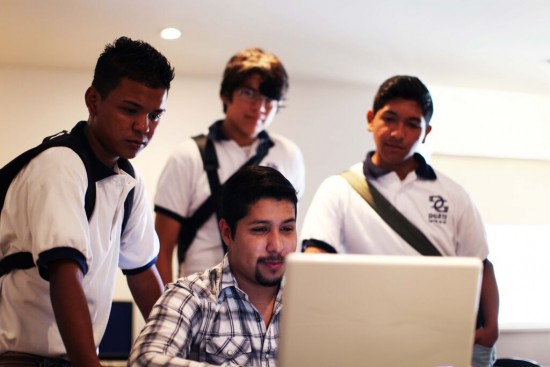This blog is also featured on Huffington Post ImpactX.
As a member of the Clinton Global Initiative (CGI), Cisco is committed to creating and implementing innovative solutions to the world’s most pressing challenges. In partnership with other global leaders, we’re tackling new issues every year, from closing the IT skills gap to creating new economic opportunities for individuals worldwide.
This year, nonprofit leaders, influential CEOs, and diplomats will come together at the CGI Annual Meeting under the theme of “The Future of Impact,” where they’ll collaborate to turn inspiring ideas into real-world results.
Together, CGI members have made more than 3,200 Commitments to Action, which have improved the lives of over 430 million people in more than 180 countries. Through countless public-private partnerships, we are preparing people around the world with the skills, technologies, and resources they’ll need to thrive in a connected world.
Through both our CGI commitments and our own Corporate Social Responsibility (CSR) program, we’ve learned what works to speed the pace of social change in communities worldwide:
1. Scaling and replicating proven solutions to underserved geographies, markets, and populations
In all corners of the world, countries are building networks to promote economic growth, and more than 24 billion devices will become connected by 2019, according to the Cisco Visual Networking Index. The explosion of connectivity — the Internet of Everything (IoE) — will connect more people, processes, data, and things to the network than ever before.
In doing so, it creates new opportunities for job seekers and businesses alike. For example, in Sub-Saharan Africa, where 40 percent of people live on less than $1.25 per day, mobile phone usage is expected to grow from 36 percent in 2013 to 49 percent by 2020. Regardless of their socioeconomic status, more and more people across Africa are finding ways to connect to the Internet, opening a world of possibilities in the IoE economy. But in order to take advantage of these connections, people need the relevant skills to fill tomorrow’s IT networking jobs.
Every year, 1 million Cisco Networking Academy students in 170 countries gain these skills, learning how to build, design, maintain and secure computer networks through hands-on activities and instruction. Since 1997, we’ve helped more than 5.5 million people develop IT and career skills. How have we achieved such scale? By leveraging the Internet and working hand-in-hand with governments, school systems, NGOs and businesses, we’ve created the “world’s largest classroom,” connecting students to the skills they need to thrive as IT professionals.

In Monterrey, Mexico, for example, Luis Alfonso escaped the violence of his neighborhood through Cisco Networking Academy courses, where he discovered a passion for networking. Knowing young people like Luis were at risk, Cisco partnered with the United States Agency for International Development (USAID), the nonprofit World Learning, and the Mexican Secretariat of Public Education to deliver an IT training and entrepreneurship program in three cities to foster stronger, more resilient communities and give youth access to educational opportunities.
Across the Atlantic Ocean, 107 vocational high schools in Turkey understand the importance of preparing students for the careers of the future. Although the country’s IT industry is expected to grow to $160 billion by 2023, less than half of its citizens are IT literate, contributing to an 18 percent unemployment rate among young people. By partnering with Cisco, the Ministry of National Education, and the Turkish Informatics Foundation, these schools are integrating Cisco Networking Academy curriculum into their courses, creating economic and career opportunities for young people. More than that, the partnership is helping the country build the skilled workforce it needs to support the digitization of its economy.
2. Democratizing social and technological innovation to drive global and local impact
The power of technology goes beyond connecting students to courses and networking skills — organizations can also reimagine what connectivity can do to benefit people, communities, and the planet. In every corner of the world, from the Arctic Circle to Africa, we’ve learned that taking a chance on innovative ideas can change lives. Often an early adopter, we are known to take calculated risks where we see opportunities for major global impact.

Our work with Digital Divide Data (DDD) is another example. DDD recruits young people living in poverty in Laos, Kenya, and Cambodia and trains them to deliver services such as data entry and document conversion to clients worldwide. Their experiences at DDD help them develop employable skills, earn an income, complete their university education, and go onto promising careers in a variety of fields. DDD graduates find jobs at three to four times the average salary in the region where they live. We supported DDD’s innovative business model when in its infancy, with cash and product grants, and now they have grown to be recognized among the world’s top 100 outsourcing companies.
In Africa, millions of people die of easily preventable diseases because they lack access to health information and affordable medicines. Living Goods addresses this problem by empowering local Health Promoters to go door-to-door providing health education and earn a living selling affordable, life-saving products like malaria medication and mosquito nets. An early-stage investment from Cisco three years ago helped Living Goods develop a mobile platform that health promoters use to follow up with clients and expand sales. Today Living Goods has nearly 1200 health promoters who have treated more than half a million children. A recent evaluation by the Children’s Investment Fund Foundation shows that Living Goods is reducing child mortality by more than 25% in Uganda. This is proof that small, early stage investments in innovative IT solutions can have a big impact on people, communities, and economies.
We also recognize that technology can have a positive impact on the planet, and we encourage organizations to find innovative ways to harness IT for both business and environmental value. For example, Cisco, Dimension Data, and the World Wildlife Foundation (WWF) came together to equip the WWF’s new UK headquarters, the Living Planet Centre, implementing Cisco technologies, including Cisco data center and collaboration solutions to help reduce WWF’s carbon footprint and create a model for workplace sustainability.
3. Making the required long-term investments to address global challenges and create opportunity for all
The examples above represent just a few of Cisco’s continual efforts to build long-lasting relationships that will change the way the world uses technology for social and environmental impact. We’re constantly learning from and collaborating with local communities to create new programs that can grow and thrive long after our initial investment is over.

One example is our 5-year, $10 million CGI commitment in 2007 to create Community Knowledge Centers (CKC) in five developing African countries. There, young men and women have access to technology and a clearer path to educational opportunities thanks to Cisco’s partnership with local nonprofits and like-minded businesses. In South Africa, we worked with Siyafunda and other local partners to launch three CKCs; using the original Cisco blueprint, Siyafunda now manages more than 100 centers where community members can access computers, the Internet, and training. As a result, they are improving their economic opportunities and job prospects, and developing the tools to break free from poverty and thrive.
We believe “The Future of Impact” lies in working together to find innovative ways to solve the world’s problems with technology. From education to environmental sustainability to employment, Cisco will continue to collaborate with public and private organizations to make a difference in every corner of the globe.
Find out more about what we’ve learned from our social investments during a CGI livestream of the CNBC Broadcast Session “Making the Economy Work for People” on Monday, September 28 from 11:00 a.m. to 12:30 p.m. ET
Cisco Executive Chairman John Chambers will join Jim Brett, president of West Elm, and John McFarlane, chairman of Barclays, to discuss how CGI members can, among other things, accelerate access to services through digitization to support thriving livelihoods and financial wellbeing for all.
Follow all the action on Twitter at @CiscoCSR and #CGI2015


Great things!
Great work you are doing..but here in india we dnt get much opportunities..
we’d like you to help us study and work in USA through a program of yours..
I want to take this initiative and would love to work with you if i get a chance..
you can have an aptitude test for the selection..
pls give a response as soon as you can
thank you.
deepak.chaudhary1911@gmail.com
Proud that Cisco is part of this and proud that I am part of Cisco!
Hi Deepak.
Cisco Networking Academy courses are offered at almost 200 locations in India. Currently more than 20,000 students are enrolled.
Networking Academy courses are a great way to build your IT and career skills and prepare for certifications that are recognized worldwide.
You can learn more about Networking Academy courses here:
https://www.netacad.com/courses
And search for an institution that offers them in your area through our Academy Locator here:
https://www.netacad.com/get-started/academy-locator